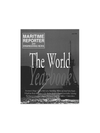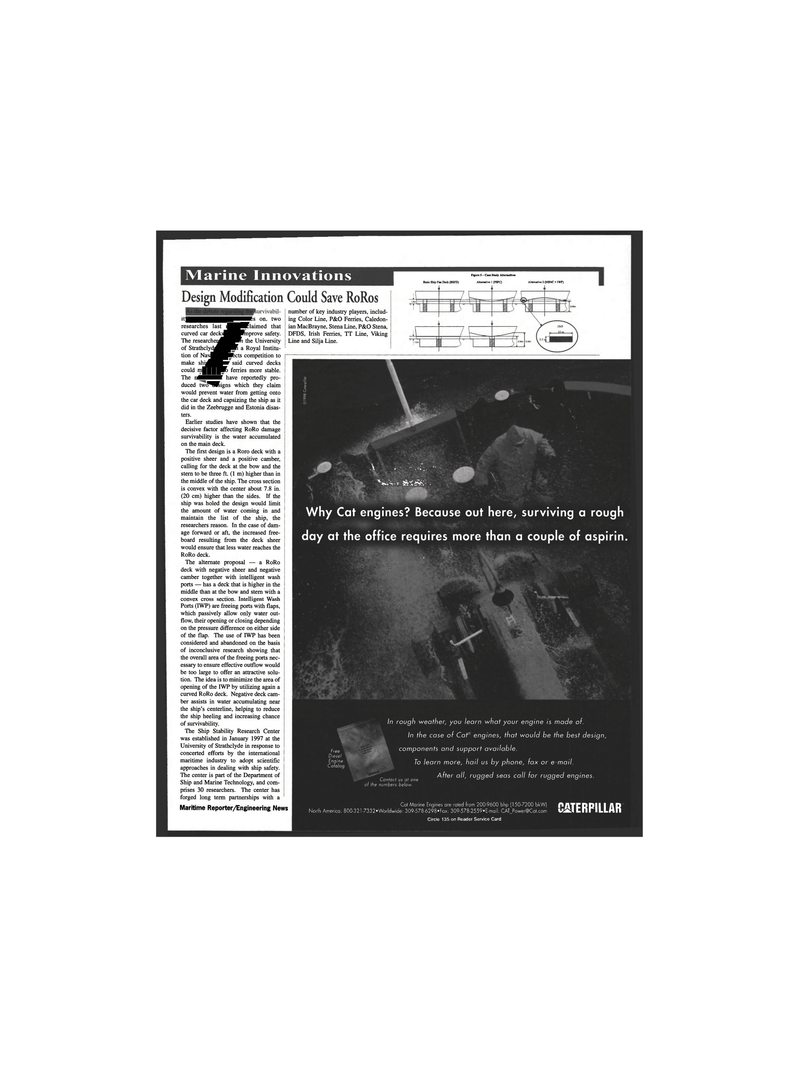
Page 63: of Maritime Reporter Magazine (June 1999)
Read this page in Pdf, Flash or Html5 edition of June 1999 Maritime Reporter Magazine
Marine Innovations iti^^HHI^Mes two researches last l^^^B^aimed that curved car decks^^^^Pmprove safety.
The researchei^^^^Ki the University of vStrathclyd^^^^K a Royal Institu- tion of Nav^^^^Kcts competition to make shi^^^^v said curved decks could m^^^^R ferries more stable.
The have reportedly pro- duced twt^GKigns which they claim would prevent water from getting onto the car deck and capsizing the ship as it did in the Zeebrugge and Estonia disas- ters.
Earlier studies have shown that the decisive factor affecting RoRo damage survivability is the water accumulated on the main deck.
The first design is a Roro deck with a positive sheer and a positive camber, calling for the deck at the bow and the stern to be three ft. (1 m) higher than in the middle of the ship. The cross section is convex with the center about 7.8 in. (20 cm) higher than the sides. If the ship was holed the design would limit the amount of water coming in and maintain the list of the ship, the researchers reason. In the case of dam- age forward or aft, the increased free- board resulting from the deck sheer would ensure that less water reaches the
RoRo deck.
The alternate proposal — a RoRo deck with negative sheer and negative camber together with intelligent wash ports — has a deck that is higher in the middle than at the bow and stern with a convex cross section. Intelligent Wash
Ports (IWP) are freeing ports with flaps, which passively allow only water out- flow, their opening or closing depending on the pressure difference on either side of the flap. The use of IWP has been considered and abandoned on the basis of inconclusive research showing that the overall area of the freeing ports nec- essary to ensure effective outflow would be too large to offer an attractive solu- tion. The idea is to minimize the area of opening of the IWP by utilizing again a curved RoRo deck. Negative deck cam- ber assists in water accumulating near the ship's centerline, helping to reduce the ship heeling and increasing chance of survivability.
The Ship Stability Research Center was established in January 1997 at the
University of Strathclyde in response to concerted efforts by the international maritime industry to adopt scientific approaches in dealing with ship safety.
The center is part of the Department of
Ship and Marine Technology, and com- prises 30 researchers. The center has forged long term partnerships with a
Maritime Reporter/Engineering News number of key industry players, includ- ing Color Line, P&O Ferries, Caledon- ian MacBrayne, Stena Line, P&O Stena,
DFDS, Irish Ferries, TT Line, Viking
Line and Silja Line. \ .. V J*, ».
J. as . < * *•«> - i
Why Cat engines? Because out here, surviving a rough day at the office requires more than a couple of aspirin. * :
Free
Diesel
Engine
Catalog
In rough weather, you learn what your engine is made of.
In the case of Cat® engines, that would be the best design, components and support avai lable.
To learn more, hail us by phone, fax or e-mail.
After all, ruqqed seas call for ruqqed enqines. llnrl lie .-if nno ' ^ & Z) O Contact us at one of the numbers below.
Cat Marine Engines are rated from 200-9600 bhp (150-7200 bkW) PATE DDI I IAD
North America: 800-321-7332»Worldwide: 309-578-6298• Fax: 309-578-2559*E-mail: CAT [email protected] USJ £111 ILLHri
Figure 5 - Case Study Alternatives
Basis Ship Flat Deck (BSFD) Alternative 1 (PSPC) Alternative 2 (NSNC + IWP)
Circle 135 on Reader Service Card

 62
62

 64
64
